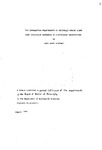THE GERMINATION REQUIREMENTS OF NATURALLY BURIED SEEDS WITH PARTICULAR REFERENCE TO FLUCTUATING TEMPERATURES
| dc.contributor.author | WHATLEY, JEAN CAROL | |
| dc.contributor.other | School of Biological and Marine Sciences | en_US |
| dc.date.accessioned | 2013-10-29T11:52:21Z | |
| dc.date.available | 2013-10-29T11:52:21Z | |
| dc.date.issued | 1984 | |
| dc.identifier | NOT AVAILABLE | en_US |
| dc.identifier.uri | http://hdl.handle.net/10026.1/2442 | |
| dc.description.abstract |
An apparatus is described which enables a layer of soil, containing naturally buried seeds, to be subjected to controlled temperature fluctuations over the range 5 C to 30 C, in the presence or absence of light. Results obtained from the use of this apparatus are presented for fourteen species, all common constituents of the buried seed bank and nearly all weeds of arable land or pasture. At least partial inhibition of germination by darkness is found in all fourteen species and stimulation of germination by temperature fluctuations in all but one. In several species strong inhibition by certain constant temperatures is overcome by the inclusion of these temperatures in a fluctuating temperature regime but in some cases germination is inhibited by very large fluctuations. In the field the temporal pattern of germination for six of the above species is recorded and related to variations in the environment. When soil moisture is maintained at field capacity the timing of germination can be predicted from the temperature response curves found in the laboratory. The initial flush in the field seems to be governed by chilling requirements. There is some evidence that a requirement for temperature fluctuations may be induced by burial. Laboratory tests on harvested Rumex obtusifolius seeds suggest that the length of exposure to far-red light before burial affects the subsequent responsiveness to temperature fluctuations. The possible mechanisms underlying the germination responses of buried seeds and the ecological significance of the results are discussed. | en_US |
| dc.language.iso | en | en_US |
| dc.publisher | University of Plymouth | en_US |
| dc.title | THE GERMINATION REQUIREMENTS OF NATURALLY BURIED SEEDS WITH PARTICULAR REFERENCE TO FLUCTUATING TEMPERATURES | en_US |
| dc.type | Thesis | |
| plymouth.version | Full version | en_US |
| dc.identifier.doi | http://dx.doi.org/10.24382/3529 | |
| dc.identifier.doi | http://dx.doi.org/10.24382/3529 |
Files in this item
This item appears in the following Collection(s)
-
01 Research Theses Main Collection
Research Theses Main


